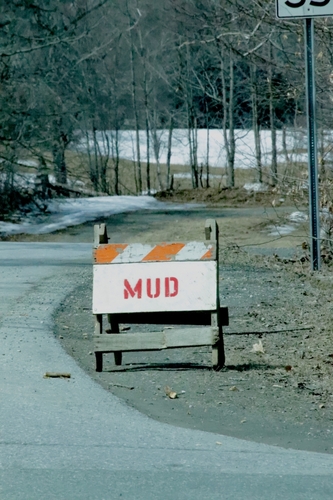WESTMINSTER — We moved to our current location in 1989, when I was 24 and my partner was 27. It was summer, glorious summer, and we answered an ad to vacate our teensy one-bedroom basement apartment.
The ad read: Rustic 1{1/2}-bedroom cabin. Must have 4WD.
It sounded like fun, like an adventure.
The little hippie shack has long since fallen down, and an actual house has taken its place. Full septic, passive solar gain, a smart setting on the parcel with southern exposure rather than tucked down in the darkest hollow - these all help us to feel more comfortable in our third decade on the hill.
We've learned and changed a lot about how we live, but one thing we can't change is the road.
* * *
It's a mystery, really, what will yield a boring, yawn-filled mud season and what will create circumstances that result in your vehicle being sucked up to its hubs in a remarkably viscous colloidal sort of brown soup.
Then, of course, no one else can pass, and there's a good chance whoever's coming to tow you (unless it's in their tractor) will also get stuck.
Is it the cycles of thawing and freezing? The inches of snowfall or lack thereof?
One cannot really predict how long mud season will be, though plenty of folks make their theories known.
“Wind dries out the road.”
“The rain pulls the cold out of the road.”
And the shared driving strategies are just as entertaining.
“Keep your gear low and your revs up!”
“Aim for the high spots.”
“No, aim for the trenches, so you're not churning the mud up more!”
* * *
Mud season can be the great leveler. When it's really bad, everyone, young or old, rich or poor, hermit-like eccentric and business professional alike - we all have to hoof it some distance.
The worst year since we've lived here was 2014, when we had to park the car and walk the last 2{1/2} miles to the house.
When driving, you learn to pick your path carefully to avoid washboards, ruts, potholes, and quicksand. You learn to slow down - barely cresting 10 mph. You learn exactly what the clearance of your car is.
When you're home, you learn to plan your day differently: What do I need for my job, recreational thing, and errands, and how do I carry everything all at once?
You remember to chuck your mud boots, an umbrella, and a headlamp in the car. Maybe a shovel.
If you're lucky, it will be a moonlit night, and the coyotes and barred owls sing as you slog up the muddy hill.
* * *
You learn to talk to your neighbors - especially the ones with the tall, tall pickup trucks - to hitch a ride, or to offer a ride if you've got the tall car, or to ask if anyone needs anything from town that can reasonably be carried on foot.
You learn to say no to the extracurriculars, to social engagements, to board meetings or classes because you simply just can't anymore.
I know someday the mud will dry up. Mud Season usually ends by May Day. But then, look out!
Because we're all trying to make up for lost time by driving like the wind down a smooth, clear road.
